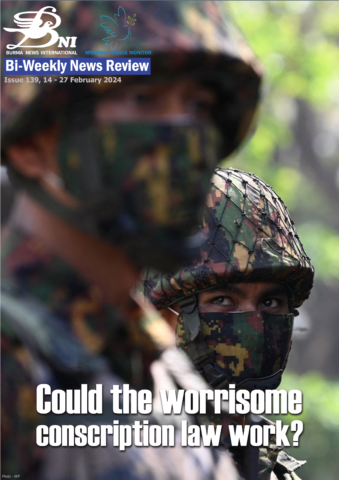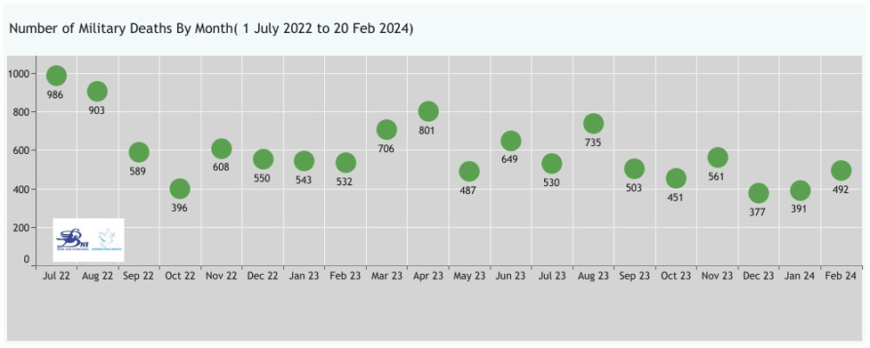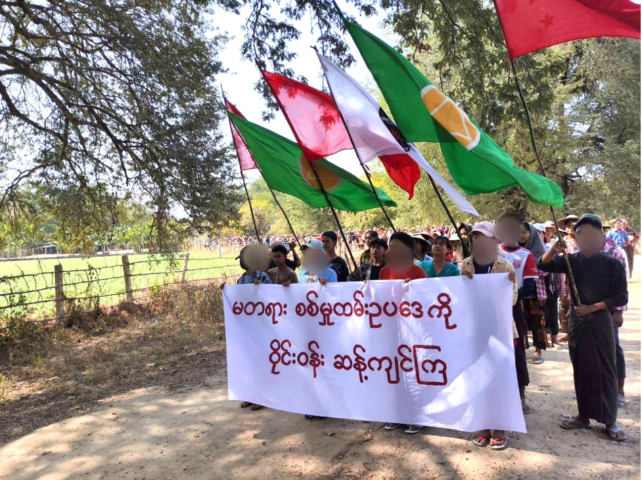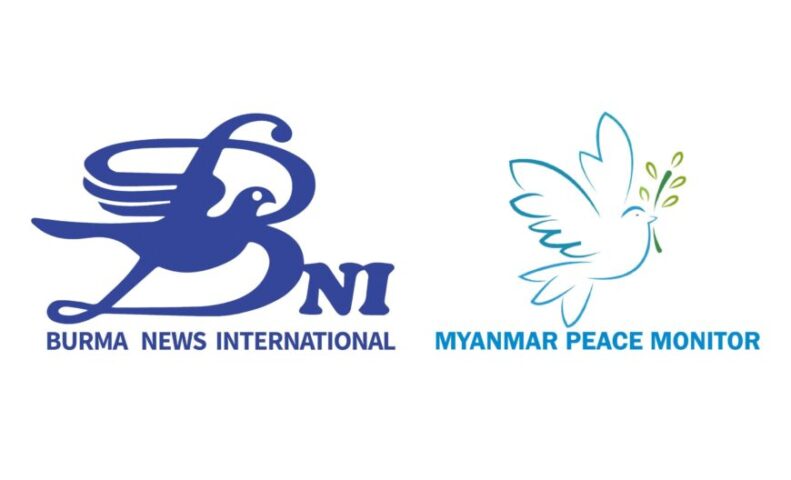
Introduction
Since the military council declared the activation of the People’s Military Service Law on 10 February, the people of Myanmar have had worries and anxieties every day. Some young citizens who are eligible for conscription, are preparing to go abroad, flee to liberated areas and join People’s Defense Forces/Local Defense Forces (PDFs/LDFs) fighting against the military junta.
According to the interim census 2019, there are nearly 14 million people—6.3 million men and 7.7 million women—who are eligible for military service under the People’s Military Service Law. Will these numbers really exist in Myanmar? Do you believe that even the said numbers will proudly serve in the military “for the defence of the country”? In addition, how many of the eligible persons are among the forces of the Spring Revolution, who are resisting the military coup by all means?
This week, the Burma News International (BNI)-Myanmar Peace Monitor’s Bi-weekly news review studies, whether the People’s Military Service Law work or not, based on the data and incidents, even though the activation of the “People’s Military Service Law” which is used by the junta as a last resort can cause great public concern.
Why is the conscription law enacted?
Major General Zaw Min Tun, leader of the junta’s press team said: “Every citizen has the duty to undergo military training and perform national defense duties.” The activation of the People’s Military Service Law can only be viewed as an official recruitment program for the junta.
According to the records of the BNI-MPM, nearly 12,000 military council soldiers died on various military fronts across the country during 20 months from July 2022 to 20 February 2024. 1 The death toll of military council soldiers may be higher on the ground during the nationwide revolutionary war waged by Ethnic Revolutionary Organizations (EROs), the PDFs/LDFs and PDF battalions and units under the National Unity Government (NUG).

In addition, the number of military and police personnel who have defected to the Spring Revolution forces and joined the Civil Disobedience Movement (CDM) has reached thousands. 2 A total of 2,389 military personnel including brigadier-generals, officers and other ranks from Laukkai Regional Operations Command surrendered with their weapons when the Myanmar National Democratic Alliance Army (MNDAA) and revolutionary forces seized complete control of Laukkai in Kokang in northern Shan State during “Operation 1027” on 4 and 5 January 2024. 3
The junta has tried various means to remedy a terminal decline in the number of soldiers due to the huge losses of soldiers in the battles between the revolutionary forces and the military council and mass surrenders across the country during over three years of coup attempt. For instance, sending jailed soldiers to the front lines, recalling retired military personnel and assigning security duties and forming the militia forces by organizing pro-military supporters.
Now, the junta announced the activation of the People’s Military Service Law on 10 February and the Reserve Forces Law on 13 February, which were passed by the State Peace and Development Council (SPDC) in 2010. This is the junta’s last resort to solve the dwindling problem. If It didn’t happen as they expected, it would be possible to forcibly arrest and recruit soldiers at anytime and anywhere, regardless of age and gender.
Related effects
Under the People’s Military Service Law 2010, for the ordinary people, men aged between 18 -35 and women aged between 18-27 are eligible for military service. For experts (doctors, engineers, technicians and the persons who earn their living with another profession), men aged between 18-45 and women aged between 18-35 can be drafted into armed forces. The military service period is two years for ordinary people and three years for experts, but it can be extendable to up to five years during national emergencies.

On 12 February after the announcement of the People’s Military Service Law, the People’s Defense Force under the NUG (Yangon Region Military Command) received thousands of applications within 12 hours as it invited new recruits to apply with specified rules. The Yangon Region Recruitment Committee announced a seven-point rule for the recruitment of new soldiers. The seven rules are: They must be the ones aged between 18-35 and are in very good health, they must follow the policies established by the Ministry of Defense under the NUG, they are willing to fight together until the end of the revolution, they can perform any duties assigned at anytime and anywhere; they must obey orders; they must be loyal to the people and the revolution and who are willing to make sacrifices for the country and the people and dare to risk; and the priority will be given to the persons with higher education level. 4
More than 100 young people from Kalay Township in Sagaing Region and adjoining areas also joined the Zomi Federal Union (ZFU) /PDF-Zoland after the announcement of the military service law.
“We are in need of tarpaulins, tents, combat boots, uniforms, arms and food as a lot of people are joining us. We are still struggling with everything,” said Ko Htaw Ni, Spokesperson of PDF- Zoland. 5
Currently, many resistance forces of the Spring Revolution have issued statements inviting new recruits after the activation of the People’s Military Service Law. For instance, resistance forces such as Cobra Column 2 VENOM and White Tiger Column (Justice Soldier PDF) in Karen State, MDY-PDF, Kachin State Hkakabo PDF, Southern Shan (1005) Battalion, Tanintharyi Region Myeik District Battalion-2, Burma Liberation Democratic Front (BLDF), Student Armed Force (SAF), People’s Independence Army (PIA), Sagaing Region Shwebo District Battalion 14, (YeU-PDF), Kalay District Battalion-4, Chin National Defense Force (CNDF), Karenni Nationalities Defense Force (KNDF-BO7) and Bamar People’s Liberation Army (BPLA). 6
The concerns of the people from various walks of life, who are looking for a way to escape rather than having to serve in the military, may limit the military’s efforts to solve its dwindling problem. It can be concluded that the areas controlled by EROs and all active areas of the revolutionary forces can become the choice of young people who do not want to serve in the military under the military council.
Review
Now, the junta has lost control of more than 40 towns across the country to the revolutionary forces. Despite the ceasefire in northern Shan State, which is part of “Operation 1027”, the junta is facing the strongest offensive by the United League of Arakan/ Arakan Army (ULA/AA) in Arakan State. The revolutionary forces all over the country are also preparing to step up their momentum from the pre-offensive to the town-capture battles.
Even though the junta’s activation of the People’s Military Service Law and the Reserve Forces Law is aimed at upholding our three main national causes and safeguarding the country, there is no one who is preparing to proudly serve in the military. It must be said that the youths are considering different options—going abroad, moving to the liberated areas and joining the revolutionary forces.
Therefore, even though the activation of “the People’s Military Service Law" which is used as a last resort by the junta, has caused great public concerns, the junta’s efforts to deal with the declining problem shall not measure up to its expectations.
1. People’s Défense Force Dashboard (1 May 2021 – 20 Feb 2024), Myanmar fatalities
2. COUP – January 2024 DASHBOARD
3. MNDAA announces it has taken complete control of Laukkai.
4. Thousands enlist PDF members at Yangon Region Command.
5. Two weeks after the enactment of mandatory conscription law, more than 100 young men join PDF Zoland
6. Revolutionary forces are recruiting new soldiers.
